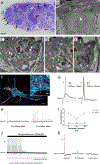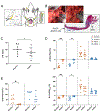Innervation and Neuronal Control of the Mammalian Sinoatrial Node a Comprehensive Atlas
- PMID: 33629877
- PMCID: PMC8284939
- DOI: 10.1161/CIRCRESAHA.120.318458
Innervation and Neuronal Control of the Mammalian Sinoatrial Node a Comprehensive Atlas
Abstract
[Figure: see text].
Keywords: autonomic nervous system; electrophysiology; neuroanatomy; neurophysiology; sinoatrial node.
Figures








Comment in
-
The Heart's Little Brain: Shedding New Light and CLARITY on the "Black Box".Circ Res. 2021 Apr 30;128(9):1297-1299. doi: 10.1161/CIRCRESAHA.121.319148. Epub 2021 Apr 29. Circ Res. 2021. PMID: 33914607 Free PMC article. No abstract available.
Similar articles
-
Zebrafish heart as a model to study the integrative autonomic control of pacemaker function.Am J Physiol Heart Circ Physiol. 2016 Sep 1;311(3):H676-88. doi: 10.1152/ajpheart.00330.2016. Epub 2016 Jun 24. Am J Physiol Heart Circ Physiol. 2016. PMID: 27342878 Free PMC article.
-
The enigmatic cardiac fat pads: critical but underappreciated neural regulatory sites.J Cardiovasc Electrophysiol. 2002 Sep;13(9):902-3. doi: 10.1046/j.1540-8167.2002.00902.x. J Cardiovasc Electrophysiol. 2002. PMID: 12380929 No abstract available.
-
Whole-mount demonstration of cholinesterase-containing nerves in the right atrial wall, nodal tissue, and atrioventricular bundle of the pig heart.J Anat. 1971 Apr;108(Pt 3):375-86. J Anat. 1971. PMID: 4102516 Free PMC article. No abstract available.
-
Differential autonomic control of SAN and AVN regions of the canine heart: structure and function.Prog Clin Biol Res. 1988;275:15-31. Prog Clin Biol Res. 1988. PMID: 3051007 Review.
-
Structure and function of the sinus node, AV node and His bundle of the human heart: part I-structure.Prog Cardiovasc Dis. 2002 Nov-Dec;45(3):235-67. doi: 10.1053/pcad.2002.130388. Prog Cardiovasc Dis. 2002. PMID: 12525999 Review. No abstract available.
Cited by
-
Cardioneuroablation for the Treatment of Hypervagotonic Sinus Node Dysfunction.JACC Case Rep. 2024 Jan 9;29(4):102185. doi: 10.1016/j.jaccas.2023.102185. eCollection 2024 Feb 21. JACC Case Rep. 2024. PMID: 38379643 Free PMC article.
-
Pacemaker Channels and the Chronotropic Response in Health and Disease.Circ Res. 2024 May 10;134(10):1348-1378. doi: 10.1161/CIRCRESAHA.123.323250. Epub 2024 May 9. Circ Res. 2024. PMID: 38723033 Free PMC article. Review.
-
From Psychostasis to the Discovery of Cardiac Nerves: The Origins of the Modern Cardiac Neuromodulation Concept.Biology (Basel). 2024 Apr 16;13(4):266. doi: 10.3390/biology13040266. Biology (Basel). 2024. PMID: 38666878 Free PMC article. Review.
-
Remodeling of the Intracardiac Ganglia During the Development of Cardiovascular Autonomic Dysfunction in Type 2 Diabetes: Molecular Mechanisms and Therapeutics.Int J Mol Sci. 2024 Nov 20;25(22):12464. doi: 10.3390/ijms252212464. Int J Mol Sci. 2024. PMID: 39596529 Free PMC article. Review.
-
Comparative specialization of intrinsic cardiac neurons in humans, mice and pigs.J Physiol. 2025 Mar;603(7):2043-2070. doi: 10.1113/JP286714. Epub 2024 Nov 8. J Physiol. 2025. PMID: 39513933
References
-
- Shivkumar K, Ajijola OA, Anand I, Armour JA, Chen PS, Esler M, De Ferrari GM, Fishbein MC, Goldberger JJ, Harper RM, Joyner MJ, Khalsa SS, Kumar R, Lane R, Mahajan A, Po S, Schwartz PJ, Somers VK, Valderrabano M, Vaseghi M and Zipes DP. Clinical neurocardiology defining the value of neuroscience-based cardiovascular therapeutics. J Physiol. 2016;594:3911–54. - PMC - PubMed
-
- Armour JA, Murphy DA, Yuan BX, MacDonald S and Hopkins DA. Gross and microscopic anatomy of the human intrinsic cardiac nervous system. The Anatomical Record: An Official Publication of the American Association of Anatomists. 1997;247:289–298. - PubMed
-
- Armour JA. Potential clinical relevance of the ‘little brain’on the mammalian heart. Experimental physiology. 2008;93:165–176. - PubMed
-
- Lazzara R, Scherlag BJ, Robinson MJ and Samet P. Selective in situ parasympathetic control of the canine sinoatrial and atrioventricular nodes. Circulation Research. 1973;32:393–401. - PubMed
-
- Ardell JL and Randall WC. Selective vagal innervation of sinoatrial and atrioventricular nodes in canine heart. American Journal of Physiology-Heart and Circulatory Physiology. 1986;251:H764–H773. - PubMed
Publication types
MeSH terms
Substances
Grants and funding
LinkOut - more resources
Full Text Sources
Other Literature Sources

